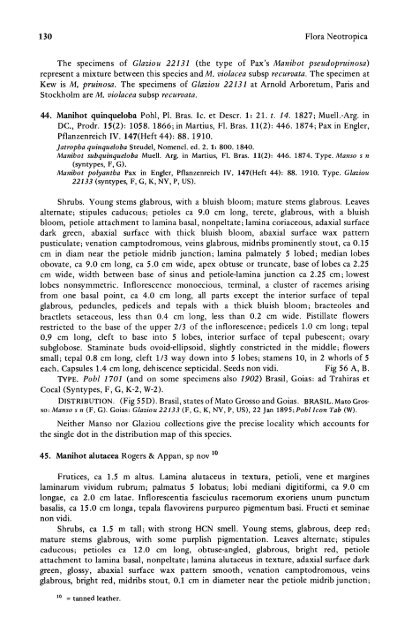Manihot Manihotoides (Euphorbiaceae) - CNCFlora
Manihot Manihotoides (Euphorbiaceae) - CNCFlora
Manihot Manihotoides (Euphorbiaceae) - CNCFlora
Create successful ePaper yourself
Turn your PDF publications into a flip-book with our unique Google optimized e-Paper software.
130 Flora Neotropica<br />
The specimens of Glaziou 22131 (the type of Pax's <strong>Manihot</strong> pseudopruinosa)<br />
represent a mixture between this species and M. violacea subsp recurvata. The specimen at<br />
Kew is M. pruinosa. The specimens of Glaziou 22131 at Arnold Arboretum, Paris and<br />
Stockholm are M. violacea subsp recurvata.<br />
44. <strong>Manihot</strong> quinqueloba Pohl, PI. Bras. Ic. et Descr. 1: 21. t. 14. 1827; Muell.-Arg. in<br />
DC., Prodr. 15(2): 1058. 1866; in Martius, Fl. Bras. 11(2): 446. 1874; Pax in Engler,<br />
Pflanzenreich IV. 147(Heft 44): 88. 1910.<br />
Jatropha quinqueloba Steudel, Nomencl. ed. 2. 1: 800. 1840.<br />
<strong>Manihot</strong> subquinqueloba Muell. Arg. in Martius, Fl. Bras. 11(2): 446. 1874. Type. Manso s n<br />
(syntypes, F, G).<br />
<strong>Manihot</strong> polyantha Pax in Engler, Pflanzenreich IV. 147(Heft 44): 88. 1910. Type. Glaziou<br />
22133 (syntypes, F, G, K, NY, P, US).<br />
Shrubs. Young stems glabrous, with a bluish bloom; mature stems glabrous. Leaves<br />
alternate; stipules caducous; petioles ca 9.0 cm long, terete, glabrous, with a bluish<br />
bloom, petiole attachment to lamina basal, nonpeltate; lamina coriaceous, adaxial surface<br />
dark green, abaxial surface with thick bluish bloom, abaxial surface wax pattern<br />
pusticulate; venation camptodromous, veins glabrous, midribs prominently stout, ca 0.15<br />
cm in diam near the petiole midrib junction; lamina palmately 5 lobed; median lobes<br />
obovate, ca 9.0 cm long, ca 5.0 cm wide, apex obtuse or truncate, base of lobes ca 2.25<br />
cm wide, width between base of sinus and petiole-lamina junction ca 2.25 cm; lowest<br />
lobes nonsymmetric. Inflorescence monoecious, terminal, a cluster of racemes arising<br />
from one basal point, ca 4.0 cm long, all parts except the interior surface of tepal<br />
glabrous, peduncles, pedicels and tepals with a thick bluish bloom; bracteoles and<br />
bractlets setaceous, less than 0.4 cm long, less than 0.2 cm wide. Pistillate flowers<br />
restricted to the base of the upper 2/3 of the inflorescence; pedicels 1.0 cm long; tepal<br />
0.9 cm long, cleft to base into 5 lobes, interior surface of tepal pubescent; ovary<br />
subglobose. Staminate buds ovoid-ellipsoid, slightly constricted in the middle; flowers<br />
small; tepal 0.8 cm long, cleft 1/3 way down into 5 lobes; stamens 10, in 2 whorls of 5<br />
each. Capsules 1.4 cm long, dehiscence septicidal. Seeds non vidi. Fig 56 A, B.<br />
TYPE. Pohl 1701 (and on some specimens also 1902) Brasil, Goias: ad Trahiras et<br />
Cocal (Syntypes, F, G, K-2, W-2).<br />
DISTRIBUTION. (Fig 55D). Brasil, states of Mato Grosso and Goias. BRASIL. Mato Grosso:<br />
Manso s n (F, G). Goias: Glaziou 22133 (F, G, K, NY, P, US), 22 Jan 1895; Pobl Icon Tab (W).<br />
Neither Manso nor Glaziou collections give the precise locality which accounts for<br />
the single dot in the distribution map of this species.<br />
45. <strong>Manihot</strong> alutacea Rogers & Appan, sp nov 10<br />
Frutices, ca 1.5 m altus. Lamina alutaceus in textura, petioli, vene et margines<br />
laminarum vividum rubrum; palmatus 5 lobatus; lobi mediani digitiformi, ca 9.0 cm<br />
longae, ca 2.0 cm latae. Inflorescentia fasciculus racemorum exoriens unum punctum<br />
basalis, ca 15.0 cm longa, tepala flavovirens purpureo pigmentum basi. Fructi et seminae<br />
non vidi.<br />
Shrubs, ca 1.5 m tall; with strong HCN smell. Young stems, glabrous, deep red;<br />
mature stems glabrous, with some purplish pigmentation. Leaves alternate; stipules<br />
caducous; petioles ca 12.0 cm long, obtuse-angled, glabrous, bright red, petiole<br />
attachment to lamina basal, nonpeltate; lamina alutaceus in texture, adaxial surface dark<br />
green, glossy, abaxial surface wax pattern smooth, venation camptodromous, veins<br />
glabrous, bright red, midribs stout, 0.1 cm in diameter near the petiole midrib junction;<br />
10 = tanned leather.

















